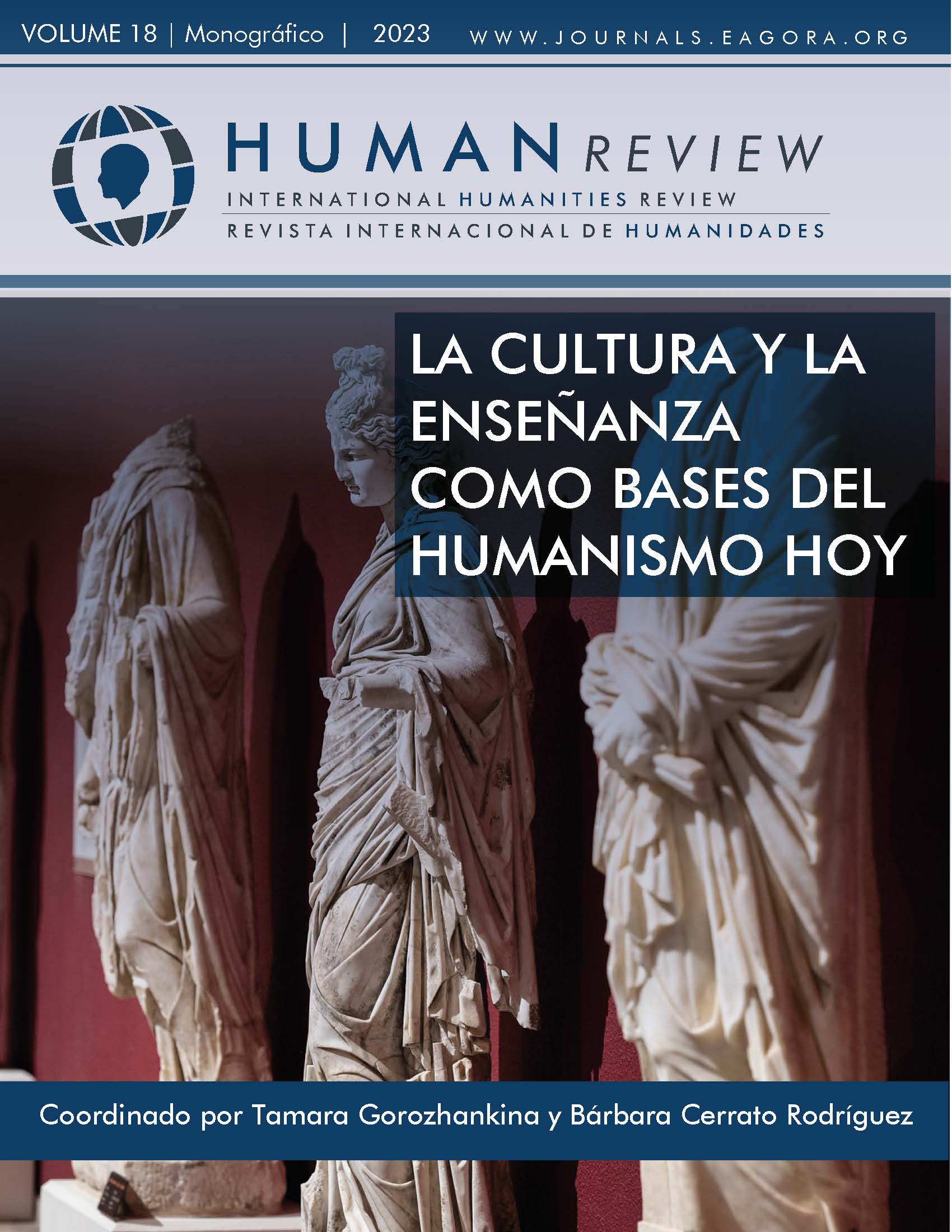The role of local history in primary education
Learning through didactic itineraries
DOI:
https://doi.org/10.37467/revhuman.v18.4881Keywords:
History, Heritage, Primary Education, Didactic itinerary, MultidisciplinaryAbstract
In the following pages we present the result of a didactic proposal implemented in the Degree in Teacher in Primary Education of the University School of Teaching of Zamora (University of Salamanca). An interdisciplinary didactic sequence was carried out, based on guided learning and cooperative work thanks to the resource of the didactic itinerary. Following what was proposed by Vygotsky and Bruner, we have aspired to the development of spontaneous and everyday learning through the use of the close environment of teachers and students -as well as their historical past-, favoring the acquisition of critical and individual thinking.
References
Azorín, J., M. (2019) Conservación y diffusion del patrimonio musical a través del aspect gráfico de los libros de texto de educación primaria. Una aproximación desde la educación musical en la Región de Murcia. Popular Music Research Today, 1, (1), 5-19. https://revistas.usal.es/uno/index.php/pmrt/article/view/pmrt.19021/20076.
Bruner, J. (1988). Desarrollo cognitivo y Educación. Selección de textos de Jesús Palacios. Morata.
Carpio, C. (2008) Métodos de enseñanza-aprendizaje aplicables en magisterio en elm arco del Espacio Europeo de Educación Superior. Docencia e investigación: revista de la Escuela Universitaria de Magisterio de Toledo, 18, 22-44.
Castro, B. & López, R. (2017) ¿Para qué sirve el patrimonio cultural? En R. López, P. Miralles & C. J. Gómez (Dirs.), Enseñanza de la historia y competencias educativas, (pp. 22-44). Grao.
Cruz, J., de León, C. J. & Gómez, A. (2022) El itinerario didáctico como recurso musical en la Educación Primaria. En H. Archilla (Ed.), Educación musical: miramos al future en las aulas, (pp. 71-74). Universidad de Extremadura. https://dehesa.unex.es:8443/handle/10662/15573.
Cruz, J., Gómez, A. & de León, C. J. (2021) Música y Ciencias Sociales en el Grado de Maestro en Educación Primaria. Innovando desde las artes en el espacio urbano. En M. A. Santos, M. Lorenzo & A. Quiroga (Coords.), La educación en Red. Realidades diversas, horizontes communes. XVII Congreso Nacional y IX Iberoamericano de Pedagogía: Santiago de Compostela 7-9 de julio de 2021, (pp. 519-520). Universidad de Santiago de Compostela. https://www.usc.gal/libros/index.php?id_product=1002&controller=product.
Egan, K. (2007). Fantasía e imaginación: su poder en la enseñanza. Ediciones Morata, S. L.
García, A. L. (1994) Los itinerarios didácticos: una de las claves para la enseñanza y comprensión de la Geografía. Iber: Didáctica de las Ciencias Sociales, Geografía e Historia, 1, 117-126.
García, M. A. (2004) El itinerario geográfico como recurso didáctico para la valoración del paisaje. Didáctica Geográfica, 79-95.
https://didacticageografica.age-geografia.es/index.php/didacticageografica/article/view/182/173.
Gómez, A., Corrochano, D. & Parra, G. (2017) Itinerarios didáctico-naturales en Educación Primaria: el noreste de Zamora. Didáctica Geográfica 18, 111-131. https://didacticageografica.age-geografia.es//index.php/didacticageografica/article/view/385/358.
Martínez, M. & Fontal, O. (2020) El patrimonio como contenido y recurso didáctico en el aula de música. En R. de la Fuente, C. Munilla & A. Martínez (Eds.) Educación, Patrimonio y Creatividad, (pp. 303-312). Verdelices Didáctica.
Olave, D. (2005) El itinerario didáctico: una propuesta metodológica para el análisis geo-histórico local. Geoenseñanza, 10, (2) 197-208.
https://www.redalyc.org/pdf/360/36010206.pdf.
Pérez, M. & Morón, H. (2016) El itinerario didáctico como herramienta para la activación patrimonial: una experiencia docente desde el Parque de María Luisa. Campo Abierto, 35, (2) 83-94. https://idus.us.es/handle/11441/69002.
Riaño, M. A. & Cabedo, A. (2013) La importancia del patrimonio musical en el aula. Estudio sobre la opinion del profesorado en educación infantil. Eufonía Didáctica de la Música, 67-78. https://repositori.uji.es/xmlui/handle/10234/166582.
San Pedro, A. B, Villalustre, L. & Herrero, M. (2019) Diseño de un itinerario aumentando e interdisciplinary para la formación de maestros en Educación Primaria. EDUTEC. Revista Electrónica de Tecnología Educativa, 68, 54-69. https://www.edutec.es/revista/index.php/edutec-e/article/view/1293.
Santolaria, A. (2014) La ciudad como recurso didáctico. EDETANIA, 45, 235-244. https://revistas.ucv.es/edetania/index.php/Edetania/article/view/189/159.
Swennen, A., Lunenberg, M. & Korthagen, F. (2008) Preach what you teach! Teacher educators and congruent teaching. Teachers and Teaching, 14, 531-542. https://eric.ed.gov/?id=EJ821090.
Trachana, A. (2014). Urbe ludens. Ediciones Trea.
Vygostki, L. S. (1984) Aprendizaje y Desarrollo intellectual en la edad escolar. Journal for the Study of Education and Development, Infancia y Aprendizaje, 27-28, 105-116.
Vygostki, L. S. (2003). La imaginación y el arte en la infancia. Akal.
Downloads
Published
How to Cite
Issue
Section
License
Those authors who publish in this journal accept the following terms:
- Authors will keep the moral right of the work and they will transfer the commercial rights.
- After 1 year from publication, the work shall thereafter be open access online on our website, but will retain copyright.
- In the event that the authors wish to assign an Creative Commons (CC) license, they may request it by writing to publishing@eagora.org









